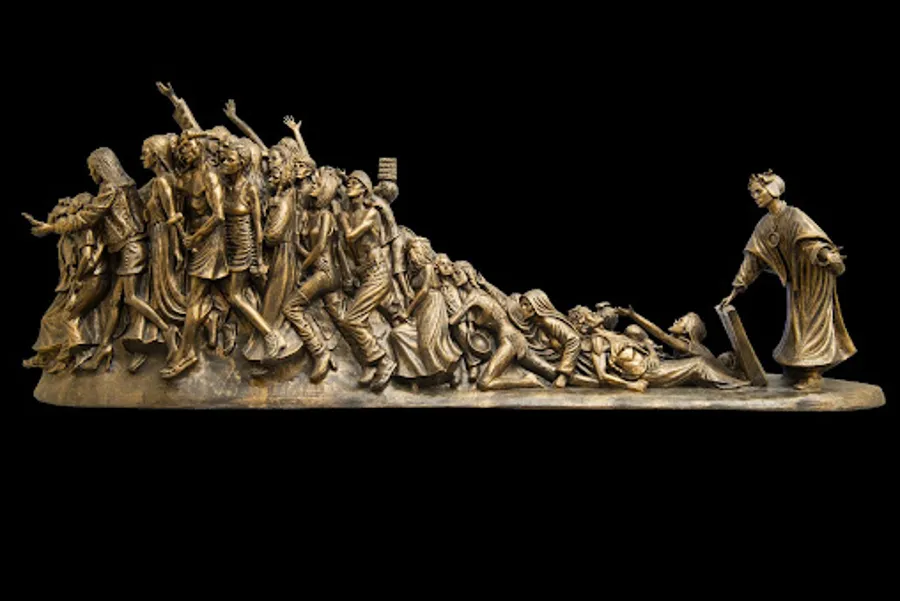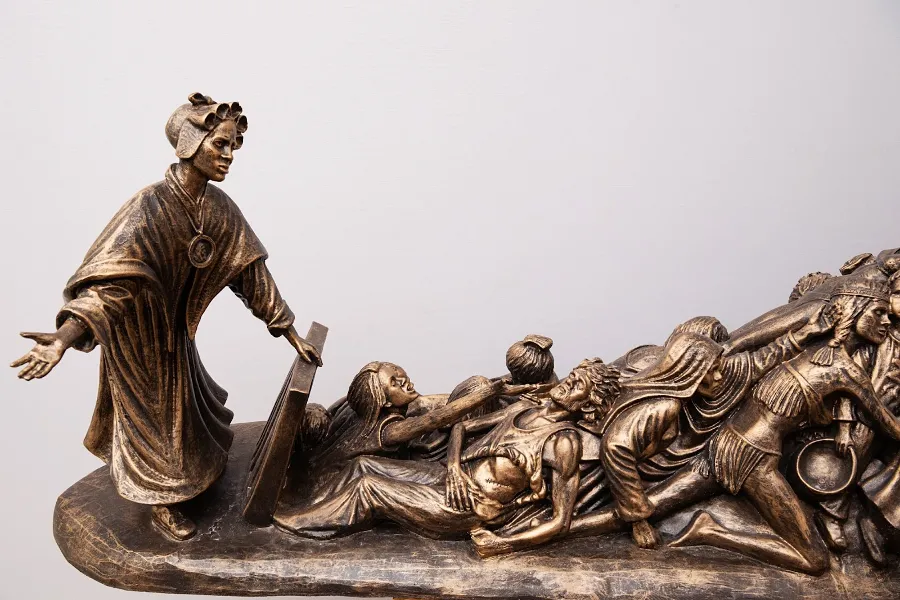St. Josephine Bakhita Sculpture Shines Light on Reality of Human Trafficking
Schmalz said the figures represent the many faces of modern-day slavery, including victims of sex trafficking and organ trafficking, domestic slaves, child brides, child soldiers, and child beggars.

VATICAN CITY — With his latest sculpture, a Catholic artist hopes to draw attention to the devastating reality of modern-day human trafficking.
The piece depicts ex-slave St. Josephine Bakhita, whose feast day is celebrated on Feb. 8, a day which also marks the eighth annual World Day of Prayer and Reflection against Human Trafficking.
“Here you have a sculpture where the hero is a Black woman, and she definitely is the hero within this piece, and she definitely is showing the world that slavery is not done with today,” Timothy P. Schmalz told CNA in a phone interview.
Called “Let the Oppressed Go Free,” the 20-foot-long sculpture, with around 100 figures, took Schmalz an entire year to create.
The work’s title is taken from the Book of Isaiah, chapter 58. “Is this not, rather, the fast that I choose: releasing those bound unjustly, untying the thongs of the yoke; Setting free the oppressed, breaking off every yoke?” the prophet says in the sixth verse.
“The sculpture is a representation of St. Bakhita lifting up the underground and letting the oppressed go free,” the Canadian artist explained.
St. Bakhita “is a Sudanese saint who was a slave in a previous century,” he said, so with this artwork, “you have a former slave from the previous century freeing the slaves of contemporary times.”
Schmalz, who was speaking from Canada, said the figures represent the many faces of modern-day slavery, including victims of sex trafficking and organ trafficking, domestic slaves, child brides, child soldiers, and child beggars.
The artist also spoke about another heart-breaking figure he included at the front of the piece.
“The sculpture is dark,” Schmalz said. He explained that when he was halfway finished with the original piece, he brought it to Rome to show to people at the Vatican and to Sister Gabriella Bottani, part of the anti-trafficking network Talitha Kum.
“Sister Gabriella said something that broke my heart,” Schmalz recounted. “She said, ‘Can I make a suggestion? Can you do one thing for me?’ And I said, ‘Yes,’ and she said, ‘Can you put a newborn baby in the sculpture?’”
“And I said ‘What?’ And she said, ‘Yes, newborn babies are sold as toys and are trafficked and sold on the black market in the world.’”
“So yes, I went back to my studio and put a newborn baby [in the sculpture]. The newborn baby is right at the beginning of the release of the figures,” Schmalz stated.
The sculptor said that through the process of researching and creating the piece, he became convinced that the whole world needs to look the reality of human trafficking in the face.
He hopes to create 10 copies of his sculpture of St. Bakhita to install all over the world for “people to look at those faces directly and to confront the problem.”
“We have to look in their faces and this sculpture allows us to do it in an artistic way. And I do believe that that’s the first step,” he said.
Schmalz works in clay before casting the statue in bronze.
In the spring, he will complete the first full-size copies of the sculpture, one of which will be installed outside the Basilica of the National Shrine of the Immaculate Conception in Washington, D.C.
Another will be placed outside St. Joseph’s Oratory in Montreal, Canada, and a third is destined for Europe.
A smaller identical model of the sculpture will be installed in the Diocese of Rome in the coming weeks. Pope Francis blessed the sculpture on Feb. 6 during his Sunday Angelus address.
“A special greeting goes to the women religious of the group Talitha Kum, who are working against human trafficking. Thank you for what you do, for your courage. Thank you. I encourage you in your work and I bless the statue of St. Josephine Bakhita,” Pope Francis said.
Schmalz explained that he had also been inspired by Talitha Kum’s work to end human trafficking, especially the sex trafficking of girls and women.
“The sisters showed me hope, because they confront the real trafficked people every day, and if you meet with [the sisters], they still have that absolute spark of joy and light within their eyes,” he said.
Schmalz is also the creator of the refugee sculpture, “Angels Unawares,” a copy of which is located in St. Peter’s Square, and which he said helped inspire the human trafficking sculpture.
Cardinal Michael Czerny, who leads the Vatican’s migrant and refugees office, suggested to Schmalz that he put his artistic skill toward making a statue on the theme of trafficking.
Schmalz said that Czerny, who is interim prefect of the integral human development dicastery, told him something which left a lasting impression.
“He said to me, if we don’t take care of the people in your one sculpture — meaning the refugee sculpture ‘Angels Unawares’ — they will end up in your other sculpture, meaning the human trafficking sculpture.”
“I didn’t necessarily know very much about human trafficking, but when I had the request to create a sculpture of it, I started working on the subject,” Schmalz explained.
He chose to depict St. Bakhita letting people up out of the underground.
“It suggests what Pope Francis mentioned years ago,” he said. “Pope Francis mentioned that human trafficking will always exist if it’s kept underground.”
“Well, this sculpture visually and literally brings artistically those that are forgotten, those that are invisible in our culture and society, out of the ground and into the daylight,” the artist said.
“I oftentimes think about this piece as being one of the first steps to fight human trafficking, and that is bringing this evil into daylight.
- Keywords:
- st. josephine bakhita
- sculpture




















